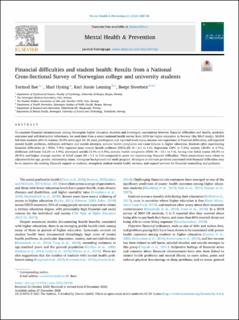| dc.description.abstract | To examine financial circumstances among Norwegian higher education students and investigate associations between financial difficulties and health, academic outcomes and self-destructive behaviours, we used data from a recent national health survey from 2018 for higher education in Norway (the SHoT study). 50,054 full-time students (69.1% women; 30.9% men) aged 18–35 years participated and reported work status, income and experience of financial difficulties, self-reported mental health problems, deliberate self-harm and suicide attempts, somatic health complaints and exam failures in higher education. Students often experiencing financial difficulties (n = 3933, 7.9%) reported more mental health problems (HSCL-25; M = 2.1 vs 1.6), depression (24% vs 7.2%), anxiety (20.8% vs 6.7%), deliberate self-harm (12.2% vs 4.9%), attempted suicide (3.1% vs 0.5%), somatic health complaints (SSS8; M = 13.1 vs 7.4), having ever failed exams (45.5% vs 28.4%) and higher average number of failed exams (M = 1.1 vs 0.6) compared to peers not experiencing financial difficulties. These associations were robust to adjustments for age, gender, relationship status, immigrant background and study program. Strategies to alleviate problems associated with financial difficulties may be to improve the existing financial support to students, strengthen student mental health services, and expand services for financial counselling and guidance. | en_US |
| dc.description.localcode | 2021 The Authors. Published by Elsevier GmbH. This is an open access article under the CC BY license (http://creativecommons.org/licenses/by/4.0/).Financial difficulties and student health: Results from a National Cross-Sectional Survey of Norwegian college and university students Tormod Bøea,*, Mari Hysinga, Kari Jussie Lønningb,c, Børge Sivertsend,e,f aDepartment of Psychosocial Science, Faculty of Psychology, University of Bergen, Bergen, Norway bThe Norwegian Medical Association, Oslo, Norway cThe Student Welfare Association of Oslo and Akershus (SiO), Oslo, Norway dDepartment of Health Promotion, Norwegian Institute of Public Health, Bergen, Norway eDepartment of Research and Innovation, HelseFonna HF, Haugesund, Norway fDepartment of Mental Health, Norwegian University of Science and Technology, Trondheim, Norway ABSTRACT To examine financial circumstances among Norwegian higher education students and investigate associations between financial difficulties and health, academic outcomes and self-destructive behaviours, we used data from a recent national health survey from 2018 for higher education in Norway (the SHoT study). 50,054 full-time students (69.1% women; 30.9% men) aged 18–35 years participated and reported work status, income and experience of financial difficulties, self-reported mental health problems, deliberate self-harm and suicide attempts, somatic health complaints and exam failures in higher education. Students often experiencing financial difficulties (n =3933, 7.9%) reported more mental health problems (HSCL-25; M =2.1 vs 1.6), depression (24% vs 7.2%), anxiety (20.8% vs 6.7%), deliberate self-harm (12.2% vs 4.9%), attempted suicide (3.1% vs 0.5%), somatic health complaints (SSS8; M =13.1 vs 7.4), having ever failed exams (45.5% vs 28.4%) and higher average number of failed exams (M =1.1 vs 0.6) compared to peers not experiencing financial difficulties. These associations were robust to adjustments for age, gender, relationship status, immigrant background and study program. Strategies to alleviate problems associated with financial difficulties may be to improve the existing financial support to students, strengthen student mental health services, and expand services for financial counselling and guidance. The social gradient in health (Chen et al., 2002; Marmot, 2005; Quon and McGrath, 2014; Reiss, 2013) is evident across a range of parameters, and those with lower education levels have poorer health, more chronic diseases and disabilities, and higher mortality rates (Avendano et al., 2009; Mackenbach et al., 2008). Recent years have seen a widening of access to higher education (Burke, 2013; Osborne, 2003; Salmi, 2018) across OECD countries; 35% of young people are now expected to obtain a tertiary education degree, with presumably high financial and social returns for the individual and society (The State of Higher Education 2015-16, 2017). Despite numerous studies documenting health benefits associated with higher education, there is an emerging public health crisis among many of those in pursuit of higher education. Systematic reviews on student health have documented disturbingly high rates of mental health problems, in particular depression, anxiety and suicidal ideation (Rotenstein et al., 2016; Tung et al., 2018), exceeding estimates in age-matched peers and the general population (Dyrbye et al., 2006; Ibrahim et al., 2013; Leahy et al., 2010; Winzer et al., 2014). There are also suggestions that the number of students with mental health prob-lems is rising (Knapstad et al., 2019; Sivertsen et al., 2019a; Storrie et al., 2010). Challenging financial circumstances have emerged as one of the significant predictors of poorer health outcomes among higher educa-tion students (Eisenberg et al., 2013; Said et al., 2013; Steptoe et al., 2007). Students accrue a sizeable debt during their education (Belfield et al., 2017), even in countries where higher education is free (State Educa-tional Loan Fund, 2019), and students often worry about their economic circumstances (Brzezinski et al., 2018; Jones et al., 2018). In a 2018 survey of 3000 UK students, 3 in 5 reported that they worried about being able to pay back their loans, and more than 80% worried about not being able to cover living expenses (Savethestudent, 2018). Objective financial indicators, such as size of debt and tuition fees, and problems paying bills have been shown to be associated with poorer health outcomes among students in higher education (Carney et al., 2005; Richardson et al., 2015; Walsemann et al., 2015), and low income has been related to self-harm, suicidal ideation and suicide attempts in this group (Toprak et al., 2011). Subjective feelings of financial stress and concerns about financial circumstances have also been linked to mental health problems and mental illness; to more aches, pains and reduced physical functioning; to sleep problems; and to worse general * Corresponding author. E-mail address: tormod.boe@uib.no (T. Bøe). Contents lists available at ScienceDirect Mental Health & Prevention journal homepage: www.elsevier.com/locate/mhp https://doi.org/10.1016/j.mhp.2020.200196 Received 22 October 2020; Received in revised form 8 December 2020; | en_US |

